W h e n S a t a n F e l l
by Jeremy Chance Springfield
The Enemy of man (Hebrew: haSatan), the ancient serpent, whom most know by the Latin-derived title of Lucifer, is a being bent on deception and lies. This entity has had an unwavering focus on men from the beginning of time. One could say he is obsessed with obtaining and maintaining our attention, to our own demise. He is an entity of unadulterated wickedness, and a master at his trade.
But he was not always like this.
Scripture tells us that he was not created in such a state. He was made without the selfishness and hate that now taint every trace of his form.
If this is the case, then, what made him change, and when did this complete corruption happen? Interestingly, this is a question so easy to ask, and yet it is one that seems so rarely answered using Scripture as a basis for an answer. Typical suggestions are that he set his heart against the Most High before the worlds were ever made. Another answer given is that he fell from grace in the time that passed between the first and second verses of the book of Genesis. Other similar answers are heard from time to time.
Well, can we go to the Word and find an accurate explanation of why and when the Enemy fell from his original state of creation? The answer is yes, and it might just surprise you on the simplicity of the truth, and in doing so, give us a better understanding of exactly who is vying for our attention, and why.
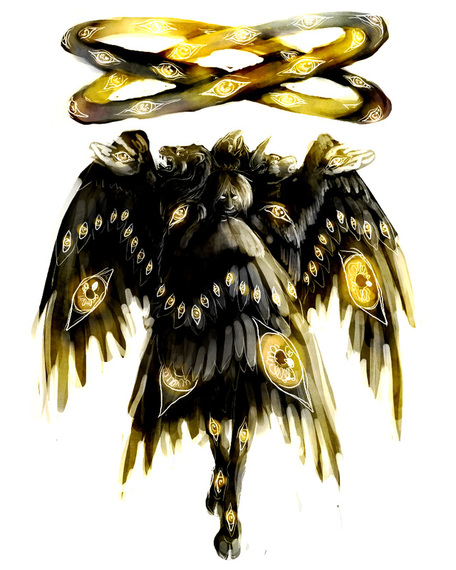
To begin, the longest description of the Enemy –both before and after his rebellion– is found in the book of Ezekiel chapter 28:11-19. In verse 13, the Word tells us that the Enemy was originally “in Eden, the garden of Elohim.” This tells us that the Enemy was indeed located in the Garden at some point. Verses 12-15 proceed to tell us all about how wonderfully beautiful he was during this time before sin entered into his being. He is called there an anointed cherub. Mind you, this is not the cute, cuddly little Greek angel-babies you see in popular art. Rather, this is the four-winged, four-headed hulking angels covered in eyes that carry the throne of the Almighty Himself in the realm of the Spirit! In the book of Ezekiel chapter 1 and chapter 10 is found the description of this angelic species in greater detail for anyone who might not be so familiar with their Biblical portrayal.
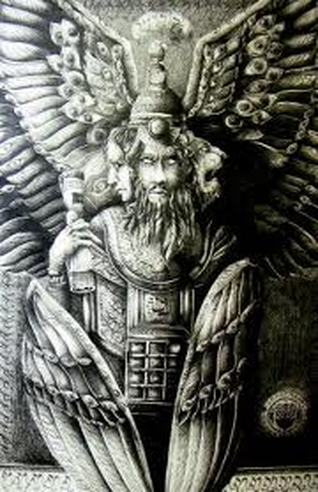
This shows us his high rank quite well.
He was adorned with many kinds of precious stones (the same precious stones that would be carried on the breastplate of the high priest in the Temple – minus three), that he was beautiful, perfect in his ways, and the expression of perfection.
Keep in mind that all this was while he was in the Garden of Eden.
However, things took a horrible turn for the worse.
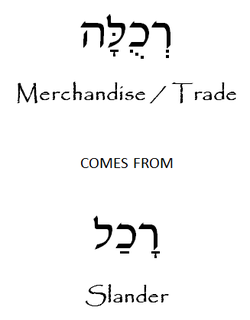
This entrance of sin into the picture says that it all had to do with the great “trade” in which he was engaged (28:16). The word “trade” is variously translated as “merchandise” / “commerce” / “traffic.” What is interesting is that this word, from the Hebrew R’KULAH, ultimately comes from the root RAKAL, and literally means “to slander / to tell a lie.” When this is understood, the nature of his “commerce” becomes glaringly obvious – it was all about A LIE.
Sin entered the perfect, anointed cherub of Eden due to a lie.
A great lie, a great trade is what brought low the expression of perfection in Eden! Speaking to the Enemy, the passage goes on to say that in response to this, the Holy One “threw you to the earth” (28:17). Not only that, but a fire would come forth from his midst, and he would be given to ashes (28:18). But even this would not be the end, no – the final state of the once-great cherub tells us that he shall “cease to be, forever” (28:19)!
Sin entered the perfect, anointed cherub of Eden due to a lie.
A great lie, a great trade is what brought low the expression of perfection in Eden! Speaking to the Enemy, the passage goes on to say that in response to this, the Holy One “threw you to the earth” (28:17). Not only that, but a fire would come forth from his midst, and he would be given to ashes (28:18). But even this would not be the end, no – the final state of the once-great cherub tells us that he shall “cease to be, forever” (28:19)!
This is the great history and prophecy of the Enemy of men. The original perfection, tragic fall, and eventual end of the anointed cherub in the Garden are contained in this passage.
Okay, so based on this passage, we now have a how.
But do we have a when?
The answer is a surprising, almost certain yes!
Okay, so based on this passage, we now have a how.
But do we have a when?
The answer is a surprising, almost certain yes!
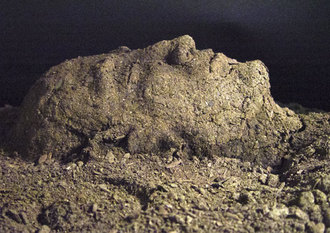
Based on the information given to us in the passage from Ezekiel, let us go all the way back to the beginning, to the book of Genesis chapter 2 and chapter 3. In 2:7, we are told that man was formed by the Creator out of the dust of the ground, breathed into by the unique Spirit of Yah, and so became alive. The next part of the chronology is where things get interesting.
A special garden is planted by the Creator on the earth, and it is there that He places this brand-spanking new man He had already made.
Okay, let us look at the chronology of events:
1st – man is made
2nd – the Garden (of Eden) is planted
3rd – the Creator places man into the Garden
4th – man is tempted by the serpent and sins
Easy enough, huh? But here is the point where we insert the information given in Ezekiel 28 into this story. Ezekiel 28 tells us that the Enemy existed in the Garden of Eden in an unfallen, perfect state, for a period of time. So where do you think he would need to be inserted in the above chain of events?
According to the timeline of events, he could only logically have been in the Garden between 2 and 3, or else between 3 and 4. That means he entered the Garden and fell after man was made, but before man was placed in the Garden, or else he entered the Garden and fell after man was placed in the Garden. Those are the only two choices Scripturally, if the timeline is to be considered. At the least, what it shows us, perhaps surprisingly, is that the Enemy existed in an unfallen state during the initial lifetime of Adam! He could not have fallen before Adam was made. There are still two choices left as to when the Enemy entered the Garden, but we know it had to have been after the creation of man, at the very least! This amazing detail is not something you will likely ever hear taught as a hard fact, but this much we can definitely know for sure.
Okay, let us look at the chronology of events:
1st – man is made
2nd – the Garden (of Eden) is planted
3rd – the Creator places man into the Garden
4th – man is tempted by the serpent and sins
Easy enough, huh? But here is the point where we insert the information given in Ezekiel 28 into this story. Ezekiel 28 tells us that the Enemy existed in the Garden of Eden in an unfallen, perfect state, for a period of time. So where do you think he would need to be inserted in the above chain of events?
According to the timeline of events, he could only logically have been in the Garden between 2 and 3, or else between 3 and 4. That means he entered the Garden and fell after man was made, but before man was placed in the Garden, or else he entered the Garden and fell after man was placed in the Garden. Those are the only two choices Scripturally, if the timeline is to be considered. At the least, what it shows us, perhaps surprisingly, is that the Enemy existed in an unfallen state during the initial lifetime of Adam! He could not have fallen before Adam was made. There are still two choices left as to when the Enemy entered the Garden, but we know it had to have been after the creation of man, at the very least! This amazing detail is not something you will likely ever hear taught as a hard fact, but this much we can definitely know for sure.
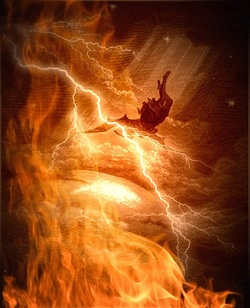
Given the evidence from Ezekiel 28, and comparing it to what we see happen in the 3rd chapter of Genesis, it actually looks like the fall of haSatan took place at basically the same time as the fall of Adam in the Garden!!!
Think about the evidence; Ezekiel says that the Enemy was perfect in the Garden until a slanderous “commerce” took place. That is, a lying sell happened. Someone was taken in a bad deal, so to speak. The result of that bad deal caused the Enemy to be thrown to the earth, and given to ashes. In contrast, the Genesis account has the serpent speaking to the woman and lying to her about what the Creator really said would happen if she ate of the tree (3:4-5). He tells her explicitly that she will not die. Yet, the Creator had said to eat of the tree would indeed bring death. Now, who is to be believed? The Creator, or the creation? The woman believes the creation over the Creator, and in doing so, brings the man into the sin, and both then fall.
But that is not the end.
Think about the evidence; Ezekiel says that the Enemy was perfect in the Garden until a slanderous “commerce” took place. That is, a lying sell happened. Someone was taken in a bad deal, so to speak. The result of that bad deal caused the Enemy to be thrown to the earth, and given to ashes. In contrast, the Genesis account has the serpent speaking to the woman and lying to her about what the Creator really said would happen if she ate of the tree (3:4-5). He tells her explicitly that she will not die. Yet, the Creator had said to eat of the tree would indeed bring death. Now, who is to be believed? The Creator, or the creation? The woman believes the creation over the Creator, and in doing so, brings the man into the sin, and both then fall.
But that is not the end.

In the giving of punishments, the serpent is punished by going henceforth upon his belly, and eating the dust of the earth. This is significant, for it parallels the casting to earth and the “given to ash” that happens to the cherub in Ezekiel 28. Interestingly, “ash” in Hebrew there is AYPHER, while “dust” in Genesis 3 is APHER – one letter difference in the Hebrew.
Yet, what is it that would make one think that the serpent of chapter 3 was yet unfallen? Couldn’t he have already rebelled? Yes, it is possible, but look at the following evidence against that idea and decide for yourself which option appears more likely.
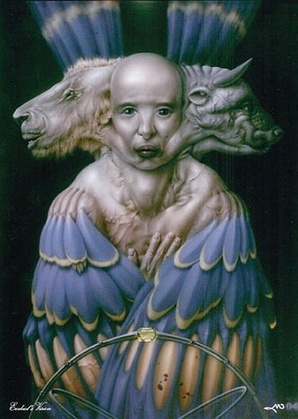
The Hebrew text itself lends the idea that he was still “perfect” in an interesting manner. At the end of chapter 2, the text tells us that the man and the woman were ARUMEEM – that is, naked / bare. Nothing separated them from Creator or creation. They were at one with all existence. Moving one verse forward, we come to chapter 3:1 (recall that chapter/verse divisions do not exist in the Hebrew). This verse speaks about the serpent, and tells us that he was “more cunning / subtle” than other creatures. The word used there for his “cunning” nature is ARUM. This word is merely the singular form of the plural ARUMEEM used one sentence before, and in a different context. Instead of saying the serpent was “naked,” it uses the word in a slightly different way, and it becomes “cunning.” But the word is actually the same word in both instances! So the word used to describe the harmonious, unfallen nature of the man and woman is also used to describe the serpent in the very next sentence! This reality should not be missed! What is this trying to tell us about the nature of the serpent at this point in the story? Perhaps he enjoyed the same manner of harmony as the man and woman – no sin?
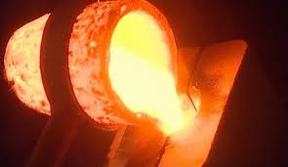
Furthermore, the very term for “Serpent” in Genesis 3:1 is NAKHASH, and while it is used often to quite distinctly mean a “snake,” the literal definition is actually “copper” – a very shiny metal in its pure state. This should be of interest to the reader, because in the book of Isaiah chapter 14:12, the Enemy is again referenced, and so is his original, unfallen state, and he is there called in the Hebrew HEYLEYL – “Shining One” – or what we know from the Latin as Lucifer!

If you think that is perhaps something of a stretch, I ask you to consider that the book of Ezekiel gives another description of cherubs – the type of angelic being that the Enemy is designated to be – and in Ezekiel 1:7, it says that they are the color of NAKHASH “copper” – using the same root word to describe the angelic creatures as is the “serpent” of Genesis 3:1!! Perhaps, then, the reference to the "serpent" in the Garden was speaking more to his shining appearance, an aspect which is repeated several times elsewhere in Isaiah and Ezekiel, even into the writings of the New Covenant, which say that he can appear as "an angel of light," (2nd Corinthians 11:14) thus maintaining the luminous characteristic he seems to exhibit quite naturally.
What this does show us, however, is that Genesis 3 labels him as the most “cunning” of the beasts of the field. The cherub angels have four faces – that of a lion, an eagle, an ox, and a man. They have four wings, and the feet of calves. This very much places them in the overall appearance of an animal. They are evidently more beast than man. But with the added face of a man – who alone is considered the Image-Bearer of the Most High – the cherub could rightly be said to be the highest expression in the created, beneath man, that is. Could this be the initiation of being lifted up because of his beauty? One can only wonder…
Taking this into consideration, what we have is the Image-Bearer – man – actually bowing down to something less than what he is intrinsically. Instead of the creation bowing to the image of the Most High, the image bowed to the creation, and a disastrous role reversal was enacted. No longer could man be considered as the king of the earth. That honor would go to the lying cherub – but only for an appointed, limited time. The Creator set events into motion that would lead to a final and irrevocable redemption of man to the role he was originally created to inhabit. That role would be realized through the Messiah Himself!
So the Enemy is real – his fall was great by way of a great and slanderous lie. Yet, we have the victory over him - should we choose to live anew through the Messiah who was sent to redeem this world from the grip of a fallen angel. Give no honor to the one who forsook his honorable place, appointed by the Creator. Give no honor to him, and all honor to the One who never lied, but who sent His Son to die for us that we might be restored!
Taking this into consideration, what we have is the Image-Bearer – man – actually bowing down to something less than what he is intrinsically. Instead of the creation bowing to the image of the Most High, the image bowed to the creation, and a disastrous role reversal was enacted. No longer could man be considered as the king of the earth. That honor would go to the lying cherub – but only for an appointed, limited time. The Creator set events into motion that would lead to a final and irrevocable redemption of man to the role he was originally created to inhabit. That role would be realized through the Messiah Himself!
So the Enemy is real – his fall was great by way of a great and slanderous lie. Yet, we have the victory over him - should we choose to live anew through the Messiah who was sent to redeem this world from the grip of a fallen angel. Give no honor to the one who forsook his honorable place, appointed by the Creator. Give no honor to him, and all honor to the One who never lied, but who sent His Son to die for us that we might be restored!
All study contents Copyright Jeremy Chance Springfield, except for graphics and images, which are Copyright their respective creators.